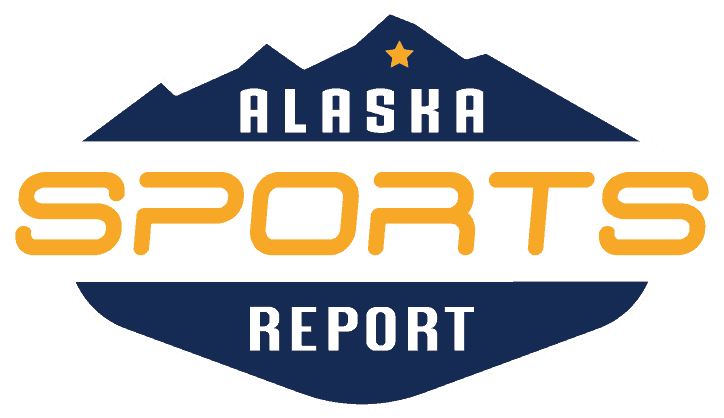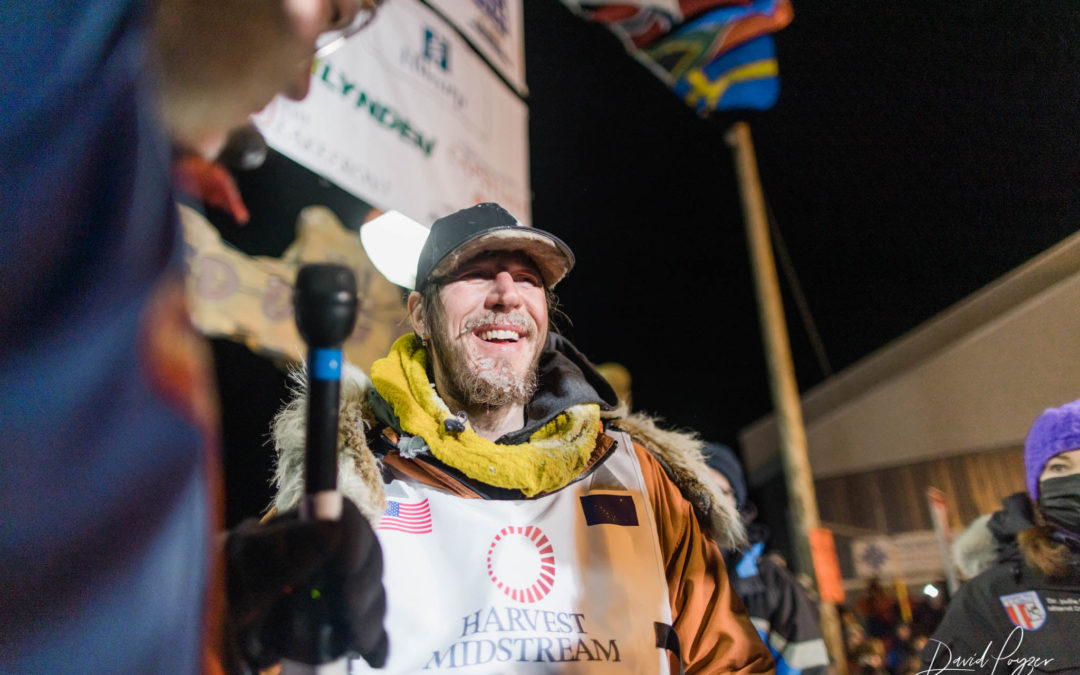
Brent Sass
Led by 6-year-old lead dogs Slater and Morello, “old-school” musher Brent Sass of Eureka fulfilled his dream by winning the 50th Iditarod Trail Sled Dog Race on Tuesday morning.
“We did it,” Sass said. “I’m happy for this dog team. Super, super, super proud. I asked a lot out of them and they performed.”
Sass also performed, looking like a throwback musher by shunning checkpoints and even camping once on the exposed sea ice. The victory, in Sass’ seventh Iditarod, was sweet redemption for past struggles that included a disqualification and a blow-up — and it came against the sport’s most dominant musher, Dallas Seavey of Talkeetna.
“That just makes it sweeter,” Sass said at the finish line. “He’s the best right now.”
Eleven dogs that Sass bred and trained at his Wild and Free Mushing kennel led Sass under the burled arch on Front Street in Nome at 5:38 a.m. to complete his run of 8 days, 14 hours and 38 minutes.

Brent Sass at the finish after his first Iditarod win. Photo by Dave Poyzer, Iditarod
Victory was seemingly assured after Sass left the final checkpoint of White Mountain on Monday night with a lead of 2 hours, 37 minutes. But Sass and his legion of fans watching his GPS tracker received a scare when he bogged down for more than an hour near the Topkop Blowhole about 50 miles from Nome due to extreme wind. That cut Sass’ lead to nine miles, the closest Seavey had been in nearly six days.
Seavey, 35, wound up finishing 1 hour, 8 minutes after Sass and now plans to take a break from Iditarod to spend more time with his 12-year-old daughter, Annie.
“You don’t win them all,” Seavey said in White Mountain.
At one point during the blowhole ordeal, Sass tumbled off the trail.
“I thought I was just going to have to bunker down and see how the cards fell. But we persevered, got up and found the trail again,” Sass said. “I don’t even know what the wind was blowing out there. I couldn’t see anything. The only we reason we got out is because they trusted me to get back to the trail, and once we got back to the trail they just took off.”
Sass, 42, seized the advantage about 400 miles into the 975-mile race from Willow to Nome by grabbing a three-hour lead on Seavey with a bold run of more than 11 hours to the Cripple checkpoint. Sass then recharged there during his mandatory 24-hour break.

Dallas Seavey
Meanwhile, Seavey, seeking a record sixth title, had to nurse some sick dogs back to health and expressed frustration that he was never able to significantly make a dent in Sass’ advantage; his deficit was stuck for days at 2-3 hours.
While most mushers prefer resting in the safety and comfort of checkpoints, Sass is a traditionalist who likes to camp in quietude with his dogs — and keep the competition guessing about his whereabouts. During this Iditarod, he passed 14 checkpoints, pausing only a few minutes to restock supplies. Sass only truly stopped at four checkpoints — three were mandatory breaks and the other was a four-hour rest in Ophir that immediately preceded his run to Cripple.
“The core of what I do is still camping and still blowing through checkpoints,” Sass told the media earlier in the race. “I’ve been doing that since day one and that continues to be my strategy.”
The biggest surprise to onlookers was Sass’ choice on Sunday to camp four hours on sea ice between Shaktoolik and Elim in winds estimated at 30-40 miles per hour; he kept his dogs comfortable by tipping his sled over as a wind break, giving them straw and coats and huddling them together in a big group; Sass said training in high winds prepared him for the moment.
Before Sass was a musher, he was a cross country skier. That’s what brought him to the University of Alaska Fairbanks in 1998.
But it wasn’t long before he watched a neighbor in Goldstream Valley mush by — and that changed his life. He ditched skiing and began collecting dogs, first mushing recreationally and then competitively. He learned the ropes from legendary musher Susan Butcher and her husband David Monson at Trailbreaker Kennel.

Brent Sass with Slater (tan dog on left) and Morello (black dog on right) in lead. Photo by Dave Poyzer, Iditarod
Butcher would die of leukemia in 2006, and Sass eventually obtained a homestead from a retired miner in the tiny outpost of Eureka where Butcher had primarily trained for her four Iditarod victories between 1986-90. Rick Swenson also trained there while amassing five Iditarod wins, but the area northwest of Fairbanks off the Ellliott Highway had seen little mushing for about two decades until Sass arrived.
Living on Joe Bush Creek year-round, Sass has made mushing an all-inclusive lifestyle.
“I would never be able to live in town and just train to race dogs,” Sass told Alaska Public Media in White Mountain. “Maybe that’s what I represent, sort of the old-school because I’m still living like Susan (Butcher) and Rick (Swenson) did back in the day. … I’m basically carrying the tradition on in Eureka with dog mushing.”
While success at the rugged and frigid Yukon Quest came quickly for Sass, along with victories there in 2015, 2019 and 2020, he’s had a tougher time figuring out the Iditarod.
His first Iditarod attempt in 2012 went well with 13th place and the Rookie of the Year Award. But he dropped to 22nd in 2013 and was disqualified in 2015 for using an IPad Touch — Sass said it was for music — that had the ability for two-way communication; the rule prohibiting such devices was abandoned a year later.
In 2016, Sass infamously chased Mitch and Dallas Seavey along the Bering Sea coast and arrived in White Mountain in third place. But his team initially refused to leave that checkpoint and he spent more than 24 hours there, an event he called the most embarrassing moment of his career that dropped him to 20th place. The incident inspired Sass to get a tattoo on his right arm that says “Run your own race.”
Sass then took three years off from the Iditarod before returning as a legitimate contender by placing fourth in 2020 and third in 2021.
Sass was presented with a check for $50,000 (his exact winning will be determined once the final musher finishes). He became just the fifth musher to win both the Yukon Quest and Iditarod, joining Seavey, Lance Mackey, Rick Mackey and Jeff King.
“It’s been overwhelming the amount of support I’ve gotten,” a grateful Sass told fans at the finish line. “I thought that was going to be a lot of pressure. It turned out to be a lot of energy.”

Brent Sass approaches the Iditarod finish line in Nome. Photo by Dave Poyzer, Iditarod

